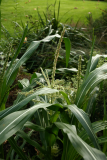Additional notes (click to expand)
Horticulture
90 days to maturity. Prefers warm fertile soil and full sun. Hill up around plants.
Horizon Herbs seed packet 2014
Medicinal
Traditional Herbal Medicine Registration (THMR).
Cancer; cholagogue; demulcent; diuretic; hypoglycaemic; hypotensive; lithontripic; stimulant;
vasodilator and warts.
Plants for a Future at www.plantsforafuture.org.uk http://www.pfaf.org/user/Plant.aspx?LatinName=Zea+mays
link
Medicinal uses
Uses supported by clinical data
The stigmas and styles of Zea mays are used for the supportive treatment
of chronic nephritis (48).
Uses described in pharmacopoeias and well established documents
The stigmas and styles of Zea mays are used for the treatment of cholangitis,
hepatitis and cholecystitis (43), and of acute and chronic cystitis and
urethritis (36). Also used in the treatment of heart disease (as a diuretic),
hypertension, rheumatism and diabetes mellitus (49).
Uses described in traditional medicine
The stigmas and styles of Zea mays have been used externally in Mayan,
Incan and American traditional medicine to treat bruises, swellings, sores,
boils, erysipelas, dermatitis and external infl ammations (22, 50, 51). Their
internal uses in the treatment of gout, gastritis, bile congestion, alcoholism,
prostatitis, benign prostatic hyperplasia, nocturnal enuresis and
whooping cough have been described (52, 53). They are also used as a
sedative and laxative (54–58). Research in China and the former USSR
countries indicates that the stigmas and styles of Zea mays lower blood
pressure and reduce blood-clotting time (21, 59). The stigmas and styles
of Zea mays are also used in the treatment of cystitis and urethritis (60).
Contraindications
Styli cum stigmatis Zeae maydis is contraindicated in patients with loss of
appetite and a low body mass or, in view of the ability of this drug to decrease
clotting time, those with high coagulability of blood (76, 80). It is
not recommended for irrigation therapy (hydro-colon therapy) in patients
with oedema due to impaired heart or kidney function (70). If signs
of hypersensitivity reactions appear (contact dermatitis and urticaria) the
styles and/or stigmas of Zea mays must not be used again.
WHO Monographs on Selected Medicinal Plants used in the Newly Independent States. 2010. WHO Geneva
Other use
Corn is one of the most commonly grown foods in the world. The seed can be eaten raw or cooked.
Toxicity
Corn/maize lacks nicotinic acid (aka niacin or vitamin B3) so if used as a sole source of food, pellagra develops.
Ball, P A J . (1981). Plants, their predators and the physician. Journal of the Royal College of Physicians, London.
Zea mays 'Hopi Blue'
Family: POACEAEGenus: Zea
Species: mays
Cultivar: 'Hopi Blue'
Common names: Corn 'Hopi Blue'
Distribution summary: Mexico, Guatemala
Habit: Annual
Garden status: Not currently grown
Flowering months: July, August, September, October
Reason for growing: Medicinal, other use, traditional herbal registration

.JPG)
.JPG)